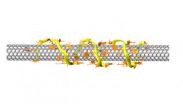(Press-News.org) Gram for gram, novel carbon nanofiber-filled coatings devised by researchers from the National Institute of Standards and Technology (NIST) and Texas A&M University outperformed conventional flame retardants used in the polyurethane foam of upholstered furniture and mattresses by at least 160 percent and perhaps by as much as 1,130 percent.
The impressive test results, reported in the journal Polymer,* suggest that significant fire-safety advantages can be gained by coating polyurethane foam (PUF) with a club-sandwich-like arrangement of thin layers containing carbon nanofibers and polymers. The upshot, says NIST researcher Rick Davis, is that the experimental coating seems to create the equivalent of a "fire-resistant armor" on the porous foam.
Ignition of soft furnishings account for about 5 percent of residential fires, and the consequences are disproportionately high. These fires are responsible for a third of fire-caused deaths of civilians and 11 percent of property losses due to fires in homes.
The flammability of mattresses is regulated by federal law. A complementary rule to regulate the flammability of upholstered furniture has been proposed recently.
Several organizations, however, have challenged the health and safety of some flame retardants designed to protect against soft furnishing fires. And, a bill pending in California would ban the use of certain halogenated flame retardants in that state.
Today, recipes for making PUFs result in foams in which fire retardants are embedded in the interior. In contrast, the experimental technology uses the carbon nanofiber fire retardant as a coating that covers all the nooks and crannies on the sponge-like PUF surface. The new approach, says Davis, should be attractive to PUF manufacturers because the surface treatment has the potential to deliver a low flammability PUF without major change to the foam manufacturing process, thus saving time and money.
The NIST-Texas A&M team coated square samples of commercially available PUF with four bilayers of a carbon nanofiber-polymer combination.** The average thickness of the coating was about 360 nanometers, increasing the mass of the foam by only 3 percent. By themselves, the carbon nanofibers accounted for 1.6 percent of the foam mass. Since the carbon nanofibers are only in the coating, all the carbon nanofibers are clumped like matted whiskers within the top 360 nanometers of the surface—assembled into the fire-blocking armor.
The team used a standard benchtop fire test to measure the fire performance of coated and uncoated PUF. The carbon nanofiber coatings reduced PUF flammability (measured as the peak heat release rate from an ignited specimen) by 40 percent. That result was more than 3 times better than achieved by putting the same carbon nanofibers in the foam (part of the foam recipe).
When compared at the same concentrations, the carbon nanofiber coating significantly outperforms three classes of commercially available flame retardants commonly used in PUF. Reductions in flammability achieved with the coating, according to the researchers, were 158 percent better than the reduction calculated for nonhalogens, 288 percent better than halogens, and 1,138 percent better than halogen-phosphorous flame retardants.
Additionally, the experimental coating "prevents the formation of a melt pool of burning foam, which in a real fire scenario, may further reduce the resulting fire threat of burning soft furnishings," the authors write.
INFORMATION:
* Y.S. Kim, R. Davis, A.A. Cain and J.C. Grunlan, Development of layer-by-layer assembled carbon nanofiber-filled coatings to reduce polyurethane foam flammability. Polymer. Vol. 52, Issue 13, June 8, 2011.
** Polyethylenimine/carbon-nanofiber.
END
DNA, a molecule famous for storing the genetic blueprints for all living things, can do other things as well. In a new paper,* researchers at the National Institute of Standards and Technology (NIST) describe how tailored single strands of DNA can be used to purify the highly desired "armchair" form of carbon nanotubes. Armchair-form single wall carbon nanotubes are needed to make "quantum wires" for low-loss, long distance electricity transmission and wiring.
Single-wall carbon nanotubes are usually about a nanometer in diameter, but they can be millions of nanometers ...
Scheduling umpire crews in Major League Baseball (MLB) can be a daunting task. However, Tallys Yunes, assistant professor of management science at the University of Miami School of Business Administration and his collaborators have created a novel solution. The team developed an efficient method to generate high-quality schedules for the MLB.
The study is titled "Scheduling Major League Baseball Umpires and the Traveling Umpire Problem" published online ahead of print by the journal Interfaces, a popular outlet for practitioners in the field of Operations Research.
...
Research led by the Warwick Crop Centre in the School of Life Sciences at the University of Warwick has developed a unique collection of information about the disease resistance of 96 of the world's onion varieties. It will be a crucial resource for commercial growers and seed producers trying to combat one of the most difficult diseases affecting onion crops. This work may also have benefits in terms of and reduced fertiliser consumption and enhanced drought tolerance.
The work on onions in this research funded by Defra (The Department for Environment, Food and Rural ...
Researchers at Emory and Georgia Tech have developed a method for predicting which areas of the coronary arteries will develop more atherosclerotic plaque over time, based on intracoronary ultrasound and blood flow measurements.
The method could help doctors identify "vulnerable plaque," unstable plaque that is likely to cause a heart attack or stroke. It involves calculating shear stress, or how hard the blood tugs on the walls of the arteries, based on the geometry of the arteries and how fast the blood is moving.
The results were posted online this week in the journal ...
New research raises troubling concerns about the use of aggressive drug therapies to treat a wide range of diseases such as MRSA, C. difficile, malaria, and even cancer.
"The universally accepted strategy of aggressive medication to kill all targeted disease pathogens has the problematic consequence of giving any drug-resistant disease pathogens that are present the greatest possible evolutionary advantage," says Troy Day, one of the paper's co-authors and Canada Research Chair in Mathematical Biology at Queen's.
The researchers note that while the first aim of a drug ...
Measuring the levels of a natural body chemical may allow doctors to reduce the duration of antibiotic use and improve the health outcomes of critically ill patients.
"Infection is a common and expensive complication of critical illness and we're trying to find ways to improve the outcomes of sick, elderly patients and, at the same time, reduce health care costs," says Daren Heyland, a professor of Medicine at Queen's, director of the Clinical Evaluation Research Unit at Kingston General Hospital, and scientific director of the Technology Evaluation in the Elderly Network.
Prolonged ...
New Rochelle, NY, August 3, 2011—Positive activity interventions (PAIs) offer a safe, low-cost, and self-administered approach to managing depression and may offer hope to individuals with depressive disorders who do not respond or have access to adequate medical therapy, according to a comprehensive review article in The Journal of Alternative and Complementary Medicine, a peer-reviewed journal published by Mary Ann Liebert, Inc. The article, "Delivering Happiness: Translating Positive Psychology Intervention Research for Treating Major and Minor Depressive Disorders" ...
In the months after the April 16, 2007, shootings at Virginia Tech, two professors administered a survey to assess posttraumatic stress among students. The findings have been published in the July 18, 2011 issue of the Journal of Psychological Trauma: Theory, Research, Practice, and Policy, published by the American Psychological Association.
According to researchers Michael Hughes, professor of sociology in the College of Liberal Arts and Human Sciences, and Russell T. Jones, professor of psychology in the College of Science, 15.4 percent of Virginia Tech students experienced ...
When we make plans that will change a natural environment — whether it's building a new shopping mall or planting a new forest — surveyors dutifully assess the environmental risks to plant and animal life in the region. But what's environmentally good for one area may be an environmental disaster for an adjacent one, a Tel Aviv University researcher cautions.
When displaced by these projects, indigenous species migrate to neighboring habitats, says Guilad Friedemann, a PhD student at TAU's Department of Zoology in the George S. Wise Faculty of Life Sciences. This has ...
People spend 3 billion hours a week playing videogames but little is known scientifically about why they are actually fun in the first place.
The vast majority of research into videogames has concentrated on the possible harmful effects of playing videogames, ignoring the simple question of why people actually want to play them.
But new research led by scientists at the University of Essex sheds some light on the appeal of videogames and why millions of people around the world find playing them so much fun.
The study investigated the idea that many people enjoy playing ...





